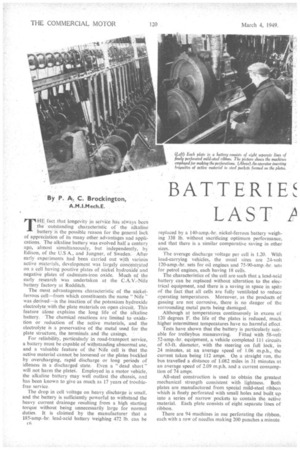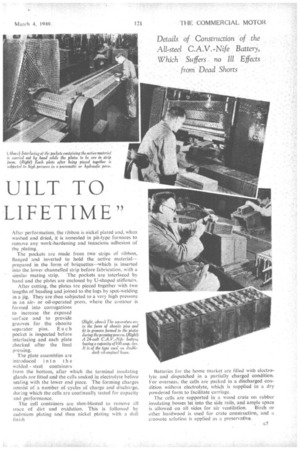BATTER tP UILT TO
Page 14

Page 15

If you've noticed an error in this article please click here to report it so we can fix it.
LAST .P
LIFETIME"
'By P. A, C. Brockington,
A.M .1.M ech.E.
THE fact that longevity in service has always been the -outstanding characteristic of the alkaline • battery is the possible reason for the general lack of appreciation of its many other advantages and applications. The alkaline battery was evolved half a century ago, almost simultaneously, but independently, by Edison, of the U.S A., and Jungner, of Sweden. After early experiments had been carried out with various active materials, development was largely concentrated on a cell having positive plates of nickel hydroxide and negative plates of cadmium-iron oxide. Much of the early research was undertaken at the C.A.V.-Nife
battery factory at Redditch. .
The most advantageous characteristic of the nickelferrous cell—from which constituents the name " Nife " was derived—is the inaction of the potassium hydroxide electrolyte with the plate materials on open circuit. This feature alone explains the long life of the alkaline battery. The chemical .reactions are limited to oxidation or reduction of the active materials, and the electrolyte is a preservative of the metal used for the plate structure, the terminals and the casings. '
For reliability, particularly in road-transport service, a battery must be capable of withstanding abnormal use, and a valuable feature of the Nife cell is that the active material cannot be loosened or the plates buckled by overcharging, rapid discharge or long periods of idleness in a discharged state. Even a "dead short" will not harm the plate. Employed in a motor vehicle, the alkaline battery may well outlast the chassis, and has been known to give as much as 17 years of troublefree service.
The drop in cell voltage on heavy discharge is small, and the battery is sufficiently powerful to withstand the heavy current drainage resulting from a high starting torque without being unnecessarily large for normal duties. It is claimed by the manufacturer that a 185-amp.-hr. lead-acid battery Weighing 472 lb. can be c6 replaced by a 140-amp.-hr. nickel-ferrous battery weighing 338 lb. without sacrificing optimum performance, and that there is a similar comparative saving in other sizes.
The average discharge voltage per cell is 1.20. With load-carrying vehicles, the usual sizes are 24-volt 120-amp-hr. sets for oil engines and 75-90-amp.-hr. sets for petrol engines, each having 18 cells, The characteristics of the cell are such that a lead-acid battery can be replaced without alteration to the electrical equipment, and there is a saving in space in spite of the fact that all cells are fully ventilated to reduce operating temperatures. Moreover, as the products of gassing are not corrosive, there is no danger of the surrounding metal parts being damaged.
Although at temperatures continuously in excess of 120 degrees F. the life of the plates is reduced, much higher intermittent temperatures have no harmful effect.
Tests have shown that the battery is particularly suit able for trolleybus manoeuvring. Fitted with 58-volt 52-amp.-hr. equipment, a vehicle completed iLl circuits of 63-ft. diameter, with the steering on full lock, in 24 minutes, at an average speed of 1.06 m.p.h., the current taken being 112 amps. On a straight run, the bus travelled a distance of 1.082 miles in 31 minutes at an average speed of 2.09 m.p.h. and a current consumption of 74 amps.
All-steel construction is used to obtain the greatest mechanical strength consistent with lightness. Both plates are manufactured from special mild-steel ribbon which is finely perforated with small holes and built up into a series of narrow pockets to contain the active material. Each plate consists of eight separate lines of ribbon.
There are 94 machines in use perforating the ribbon, each with a row of needles making 200 punches a minute. After performation, the ribbon is nickel plated and, when washed and dried, it is annealed in pit-type furnaces to .remove any work-hardening and tenacious adhesion of the plating.
The pockets are made from two strips of ribbon, flanged and inverted to hold the active material-prepared in the form of hriquettes—which is inserted into the lower channelled strip before fabrication, with a similar mating strip. The pockets are interlaced by hand and the plates are enclosed by U-shaped stiffeners.
After cutting, the plates are pieced together with two lengths of beading and joined to the lugs by spot-welding in a jig. They are then subjected to a very high pressure in an airor oil-operated press, where the contour is formed into corrugations to increase the exposed surface and to provide grooves . for the ebonite separator pins. Each pocket is inspected before interlacing and each plate checked after the final pressing.
The plate assemblies are introduced into the welded steel containers from the bottom, after which the terminal insulating glands are fitted and the cells soaked in electrolyte before sealing with the lower end piece. The forming charges consist of a number of cycles" of charge and discharge, during which the cells are continually tested for capacity and performance.
The cell containers are shot-blasted to remove all trace of dirt and oxidation. This is followed by cadmium plating and then nickel plating with a dull Finish' (Right, above) The separators are in the form of ebonite pins and fit in grooves formed in the plates during the pressing process. (Right) A 24-volt C.A.V.-Plife battery haying a capacity of160ampArs. Ills of the type used on double deck oil-engined buses. Batteries for the home market are filled with electrolyte and dispatched in a partially charged . condition. For overseas, the cells are packed in a discharged condition without electrolyte, which is supplied in a dry powdered form to facilitate carriage.
The cells are supported in a wood crate on rubber insulating bosses let into the side rails, and ample space is allowed on all sides for air ventilation. Birch or other hardwood is used for crate construction, and a creosote solution is applied as a preservative.


























